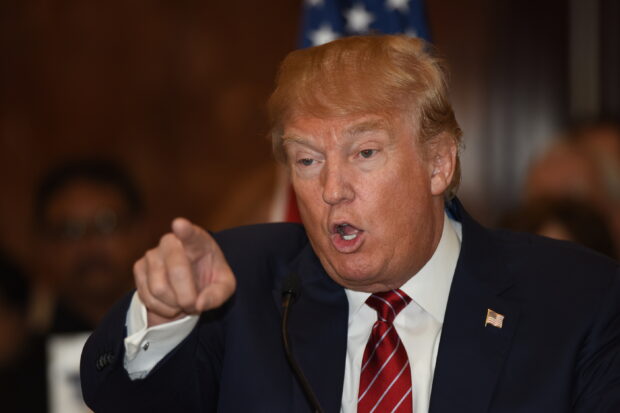A comment and promise made by former President Donald Trump on Tuesday received a lot of not-so-positive attention from the insurance industry.
“Your Automobile Insurance is up 73% — VOTE FOR TRUMP, I’LL CUT THAT NUMBER IN HALF!,” the current Republican candidate for president posted to the social media platform X.
Your Automobile Insurance is up 73% — VOTE FOR TRUMP, I’LL CUT THAT NUMBER IN HALF!
— Donald J. Trump (@realDonaldTrump) September 17, 2024
Putting aside for a moment the promise to cut premium increases, Trump’s reference to a 73 percent increase in auto insurance rates “seems to have no basis in fact—at least if one insists on using credible, verifiable sources of data,” said economist Robert Hartwig, a professor in the Moore School of Business at the University of South Carolina, and former president of the Insurance Information Institute.
Hartwig forwarded a link to his source—the U.S. Bureau of Labor Statistics—and said he found the “73 percent figure doesn’t seem to coincide with any key political dates” and it is “unclear what the source of Trump’s data is or how that number was computed—or over what period of time we’re talking about.”

“Obviously, there is a historical date for which the price of auto insurance today is 73 percent higher than it was in the past (the exact figure is 73.6 percent),” Hartwig wrote to Insurance Journal in an email. “Using the U.S, Bureau of Labor Statistics data, the date is September 2016—two months before Trump was elected and four months before he took office.”
Other sources contacted by Insurance Journal could not identify the origin of Trump’s 73 percent. However, Hartwig did relay the following facts based on BLS data:
- For the past 12 months (Aug. 2023- Aug. 2024), auto insurance rates are up 16.5 percent
- Starting Jan. 2021 (when Biden took office), the figure is 54.9 percent
- Starting Jan. 2020 (just before the pandemic began), the figure is 49.2 percent
- From Jan. 2017 (when Trump took office), the figure is 67.2 percent
Related article: Auto Insurance Price Inflation Overstated, Swiss Re Economists Say
David A. Sampson, president and CEO of the American Property Casualty Insurance Association, issued a statement following Trump’s social media post to “set the record straight.”

“In the heated arena of presidential campaigns, candidates often seize on popular issues to connect with voters, and auto insurance has recently become one of them,” Sampson said. “However, the political rhetoric surrounding the property casualty industry has often led to confusion and misrepresentations. Understanding the factors impacting auto insurance rates can help cut through the noise and focus on meaningful ways to reduce costs for consumers.”
Whether Trump intended for the post to elicit the types of comments it has received is unclear, but many commenters pointed to the illegal immigrant population as a factor in high auto insurance rates.
Hartwig said he was unaware of any study related to immigrants as a driver of high auto insurance costs, or being associated with issues related to uninsured motorist coverage. R.J. Lehmann, senior fellow at the International Center for Law & Economics, said the same.
“I wouldn’t jump to that conclusion,” Lehmann said an interview. “Uninsured or underinsured drivers may be a factor, but [in terms of illegal immigrants] I don’t know of a study. It doesn’t come up. An uninsured driver could be anybody. Rates have gone up due to claims affecting insurers’ results.”
Lehmann explained that rates were going up around 7 percent per year until the pandemic, when the volume of vehicles on the road dropped significantly and insurers weren’t increasing rates at all. But since vehicles returned to the roads, studies have shown driving behavior has taken a downturn and motor vehicle deaths have increased. Insurers are “catching up,” said Lehmann, and recent reports suggest they may have. S&P Global Market Intelligence forecasted a “dramatic return to underwriting profitability” with a personal auto 2024 combined ratio of 98.4, down from 104.9 in 2023 and 112.2 in 2022.
Premiums have risen, said Sampson, “for the simple reason that the cost of what goes into auto insurance has been rising.”
“This includes the cost of auto parts, labor, rentals, and replacement cars,” Sampson continued. “Overall, the severity of traffic accidents has spiked, leading to more expensive medical claims. To put all of this into perspective, auto insurance claims and expenses spiked to more than $1.12 for every $1 in premium in 2022. Therefore, auto insurance rates have increased in 2024, even as inflation has started to slow. Insurance prices lag inflation.”
Related Article: Personal Auto Driving P/C Insurers to 2024 Underwriting Profit
In the last five years, vehicle repairs went up nearly 21 percent, repair parts increased about 24 percent and used car values are up almost 26 percent, Sampson said in the statement. Additionally, there has been a 319 percent increase in personal injury awards during the last decade, he added, without disclosing the sources of the data.
A brief on auto insurance rates from the Insurance Information Institute highlights the same factors.
Moving back to Trump’s claim that he can affect auto insurance rates, Hartwig said, “That’s a lie.”
“Someone should explain to Trump that insurance—and insurance rates—are regulated by the states, not the federal government,” Hartwig said. “If Trump on Day 1 could wave his hands and reduce auto insurance rates by 50 percent, auto insurance would instantly cease to be sold by any auto insurer in the United States.”
“he reason, of course, is that if insurers were compelled to sell auto insurance at 50 percent of the current price this would lead to enormous losses and the eventual insolvency of the insurer—hence they wouldn’t sell any at all.”
Lehmann said he believes “Trump isn’t thinking about federal regulation,” and there is little that he or Congress can do with the system of state regulation firmly in place. However, a president could fund road infrastructure improvements or campaigns with agencies like the National Highway Traffic Safety Administration to promote safety.
This article was originally published on Insurance Journal. Reporter Chad Hemenway is the National Editor of Insurance Journal.





















 What to Expect in 2026: U.S. P/C Results More Like 2024
What to Expect in 2026: U.S. P/C Results More Like 2024  The Future of Knowledge in Insurance: From Training to AI-Powered Productivity
The Future of Knowledge in Insurance: From Training to AI-Powered Productivity  Rebuilding Negotiation Talent: Why This Skill Is Missing and How to Fix It
Rebuilding Negotiation Talent: Why This Skill Is Missing and How to Fix It  How One MGU Grew Fivefold When Capacity Fled Cat-Prone Property Markets
How One MGU Grew Fivefold When Capacity Fled Cat-Prone Property Markets 

